The Cambridge History of Japan, Vol. 4: Early Modern Japan
Подождите немного. Документ загружается.

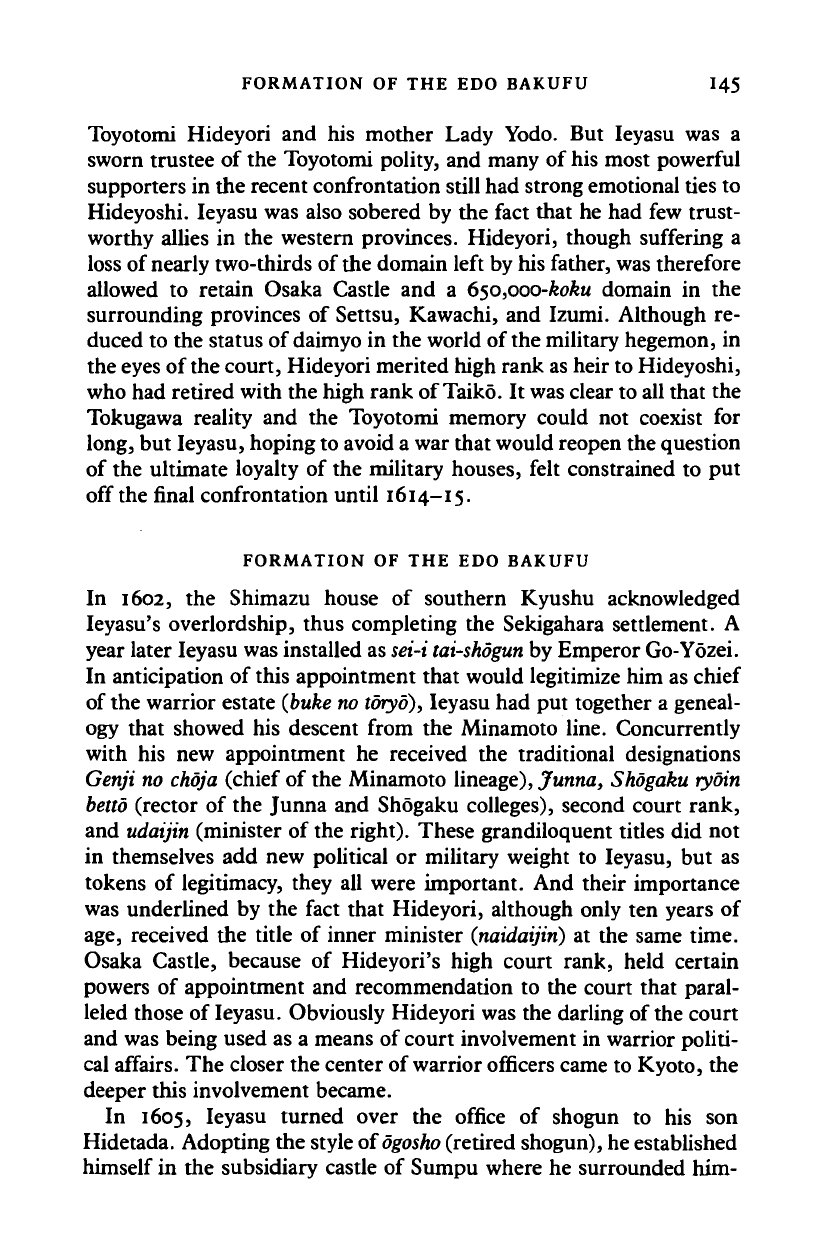
FORMATION OF THE EDO BAKUFU 145
Toyotomi Hideyori and his mother Lady Yodo. But Ieyasu was a
sworn trustee of the Toyotomi polity, and many of his most powerful
supporters in the recent confrontation still had strong emotional ties to
Hideyoshi. Ieyasu was also sobered by the fact that he had few trust-
worthy allies in the western provinces. Hideyori, though suffering a
loss of nearly two-thirds of the domain left by his father, was therefore
allowed to retain Osaka Castle and a 650,000-koku domain in the
surrounding provinces of Settsu, Kawachi, and Izumi. Although re-
duced to the status of daimyo in the world of
the
military hegemon, in
the eyes of
the
court, Hideyori merited high rank as heir to Hideyoshi,
who had retired with the high rank of
Taiko.
It was clear to all that the
Tokugawa reality and the Toyotomi memory could not coexist for
long, but Ieyasu, hoping to avoid a war that would reopen the question
of the ultimate loyalty of the military houses, felt constrained to put
off the final confrontation until 1614-15.
FORMATION OF THE EDO BAKUFU
In 1602, the Shimazu house of southern Kyushu acknowledged
Ieyasu's overlordship, thus completing the Sekigahara settlement. A
year later Ieyasu was installed as
sei-i tai-shdgun
by Emperor Go-Y6zei.
In anticipation of this appointment that would legitimize him as chief
of the warrior estate
(buke no
toryo),
Ieyasu had put together a geneal-
ogy that showed his descent from the Minamoto line. Concurrently
with his new appointment he received the traditional designations
Genji
no
choja
(chief of the Minamoto
lineage),
Junna,
Shogaku ryoin
betid
(rector of the Junna and Shogaku colleges), second court rank,
and
udaijin
(minister of the right). These grandiloquent titles did not
in themselves add new political or military weight to Ieyasu, but as
tokens of legitimacy, they all were important. And their importance
was underlined by the fact that Hideyori, although only ten years of
age,
received the title of inner minister
{naidaijin)
at the same time.
Osaka Castle, because of Hideyori's high court rank, held certain
powers of appointment and recommendation to the court that paral-
leled those of
Ieyasu.
Obviously Hideyori was the darling of the court
and was being used as a means of court involvement in warrior politi-
cal affairs. The closer the center of warrior officers came to Kyoto, the
deeper this involvement became.
In 1605, Ieyasu turned over the office of shogun to his son
Hidetada. Adopting the style of
ogosho
(retired shogun), he established
himself in the subsidiary castle of Sumpu where he surrounded him-
Cambridge Histories Online © Cambridge University Press, 2008
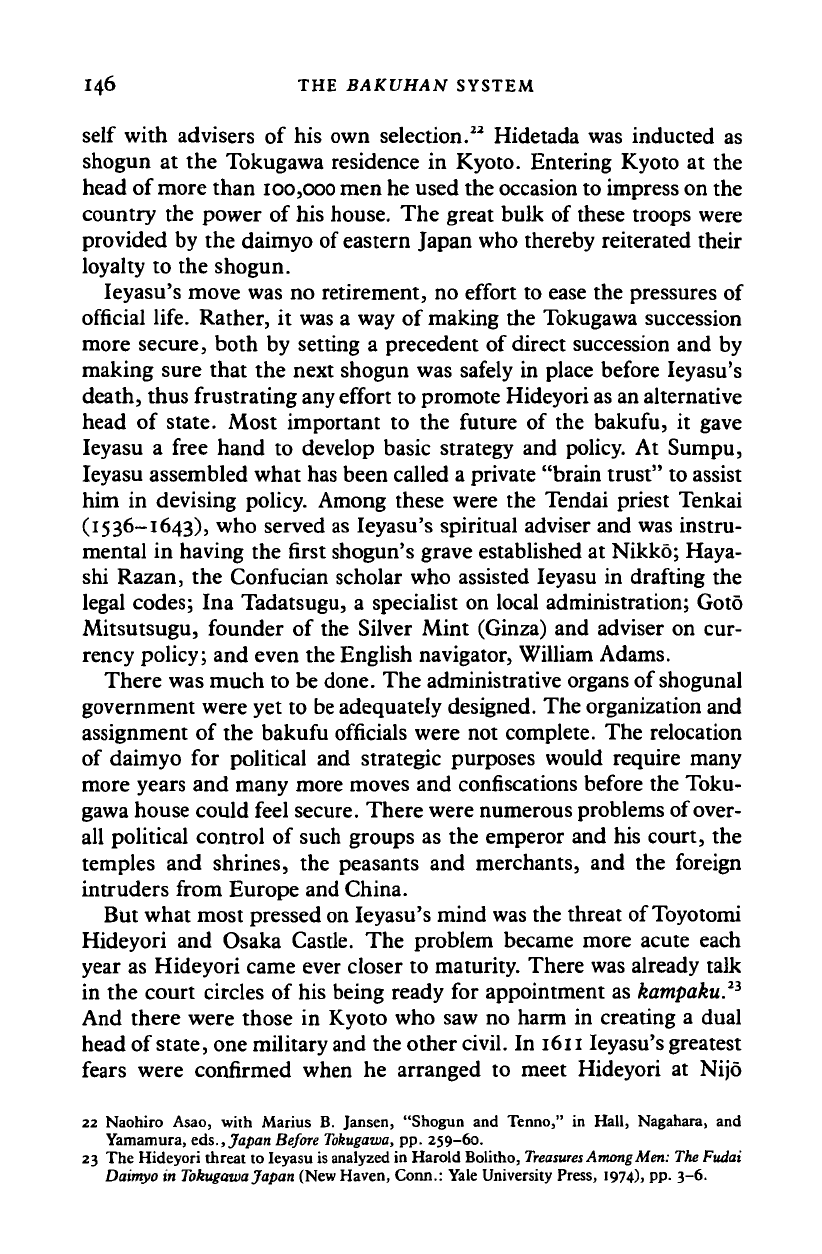
I46 THE BAKUHAN SYSTEM
self with advisers of his own selection.
22
Hidetada was inducted as
shogun at the Tokugawa residence in Kyoto. Entering Kyoto at the
head of more than 100,000 men he used the occasion to impress on the
country the power of his house. The great bulk of these troops were
provided by the daimyo of eastern Japan who thereby reiterated their
loyalty to the shogun.
Ieyasu's move was no retirement, no effort to ease the pressures of
official life. Rather, it was a way of making the Tokugawa succession
more secure, both by setting a precedent of direct succession and by
making sure that the next shogun was safely in place before Ieyasu's
death, thus frustrating any effort to promote Hideyori as an alternative
head of state. Most important to the future of the bakufu, it gave
Ieyasu a free hand to develop basic strategy and policy. At Sumpu,
Ieyasu assembled what has been called a private "brain trust" to assist
him in devising policy. Among these were the Tendai priest Tenkai
(1536-1643), who served as Ieyasu's spiritual adviser and was instru-
mental in having the first shogun's grave established at Nikko; Haya-
shi Razan, the Confucian scholar who assisted Ieyasu in drafting the
legal codes; Ina Tadatsugu, a specialist on local administration; Goto
Mitsutsugu, founder of the Silver Mint (Ginza) and adviser on cur-
rency policy; and even the English navigator, William Adams.
There was much to be done. The administrative organs of shogunal
government were yet to be adequately designed. The organization and
assignment of the bakufu officials were not complete. The relocation
of daimyo for political and strategic purposes would require many
more years and many more moves and confiscations before the Toku-
gawa house could feel secure. There were numerous problems of over-
all political control of such groups as the emperor and his court, the
temples and shrines, the peasants and merchants, and the foreign
intruders from Europe and China.
But what most pressed on Ieyasu's mind was the threat of Toyotomi
Hideyori and Osaka Castle. The problem became more acute each
year as Hideyori came ever closer to maturity. There was already talk
in the court circles of his being ready for appointment as kampaku.
2i
And there were those in Kyoto who saw no harm in creating a dual
head of
state,
one military and the other
civil.
In
1611
Ieyasu's greatest
fears were confirmed when he arranged to meet Hideyori at Nijo
22 Naohiro Asao, with Marius B. Jansen, "Shogun and Tenno," in Hall, Nagahara, and
Yamamura,
eds.,
Japan Before
Tokugawa,
pp. 259-60.
23 The Hideyori threat to Ieyasu is analyzed in Harold Bolitho,
Treasures
Among
Men:
The Fudai
Daimyo
in Tokugawa Japan (New Haven, Conn.: Yale University Press, 1974), pp. 3-6.
Cambridge Histories Online © Cambridge University Press, 2008
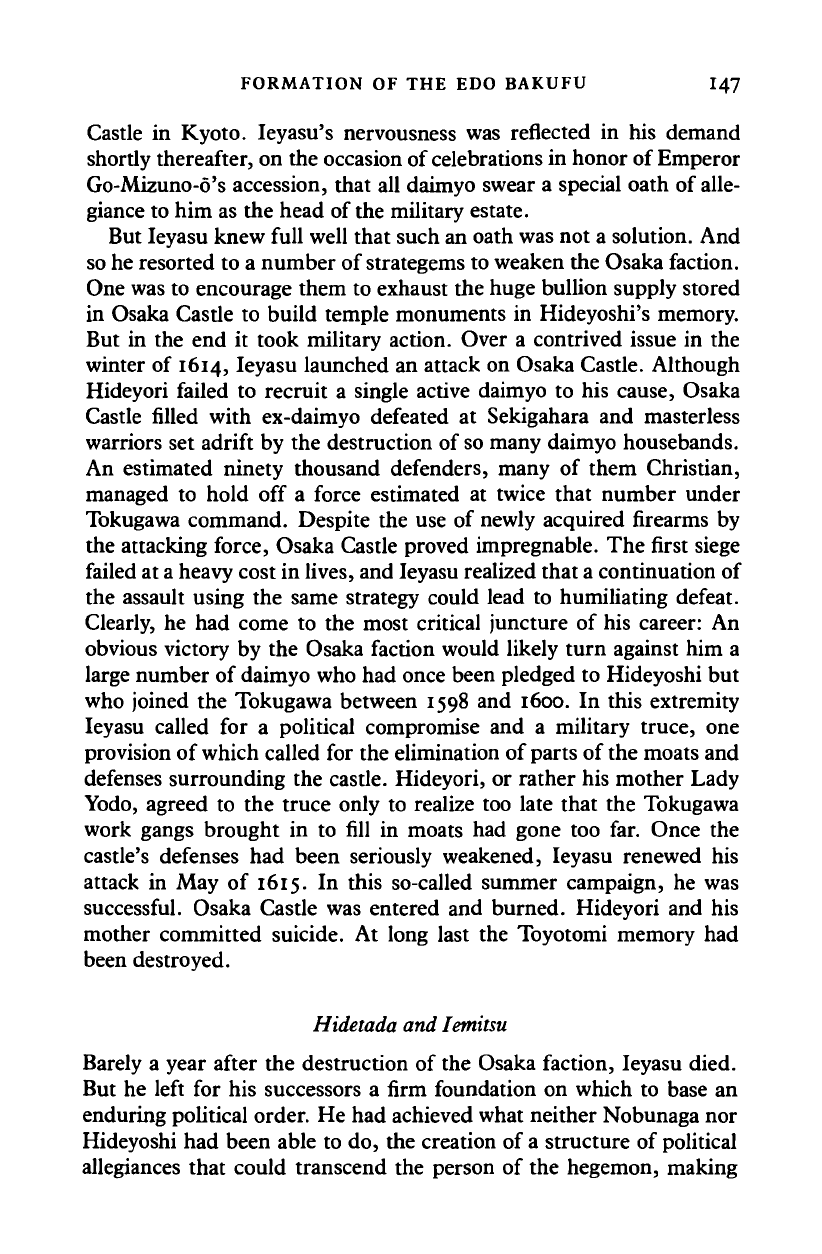
FORMATION OF THE EDO BAKUFU 147
Castle in Kyoto. Ieyasu's nervousness was reflected in his demand
shortly thereafter, on the occasion of celebrations in honor of Emperor
Go-Mizuno-6's accession, that all daimyo swear a special oath of alle-
giance to him as the head of the military estate.
But Ieyasu knew full well that such an oath was not a solution. And
so he resorted to a number of strategems to weaken the Osaka faction.
One was to encourage them to exhaust the huge bullion supply stored
in Osaka Castle to build temple monuments in Hideyoshi's memory.
But in the end it took military action. Over a contrived issue in the
winter of 1614, Ieyasu launched an attack on Osaka Castle. Although
Hideyori failed to recruit a single active daimyo to his cause, Osaka
Castle filled with ex-daimyo defeated at Sekigahara and masterless
warriors set adrift by the destruction of
so
many daimyo housebands.
An estimated ninety thousand defenders, many of them Christian,
managed to hold off a force estimated at twice that number under
Tokugawa command. Despite the use of newly acquired firearms by
the attacking force, Osaka Castle proved impregnable. The first siege
failed at a heavy cost in lives, and Ieyasu realized that a continuation of
the assault using the same strategy could lead to humiliating defeat.
Clearly, he had come to the most critical juncture of his career: An
obvious victory by the Osaka faction would likely turn against him a
large number of daimyo who had once been pledged to Hideyoshi but
who joined the Tokugawa between 1598 and 1600. In this extremity
Ieyasu called for a political compromise and a military truce, one
provision of which called for the elimination of parts of the moats and
defenses surrounding the castle. Hideyori, or rather his mother Lady
Yodo, agreed to the truce only to realize too late that the Tokugawa
work gangs brought in to fill in moats had gone too far. Once the
castle's defenses had been seriously weakened, Ieyasu renewed his
attack in May of 1615. In this so-called summer campaign, he was
successful. Osaka Castle was entered and burned. Hideyori and his
mother committed suicide. At long last the Toyotomi memory had
been destroyed.
Hidetada and Iemitsu
Barely a year after the destruction of the Osaka faction, Ieyasu died.
But he left for his successors a firm foundation on which to base an
enduring political order. He had achieved what neither Nobunaga nor
Hideyoshi had been able to do, the creation of a structure of political
allegiances that could transcend the person of the hegemon, making
Cambridge Histories Online © Cambridge University Press, 2008

148 THE BAKUHAN SYSTEM
the office of shogun the permanent object of national loyalty and
obedience. This obviously was Ieyasu's main intent when he resigned
the office of shogun. During the "Ogosho era" he was able to take a
number of important steps toward the institutionalization of the post
of shogun. Toward the Kyoto court he exploited every occasion to
impose his authority. A particularly sensitive issue was control over
the award of court titles
to
members of the.bushi class. In
1613,
on the
occasion of a court intrigue involving Hideyori, Ieyasu had promul-
gated a code of regulations, the Kuge shohatto, directed toward the
nobility and restricting their involvement in political affairs. Docu-
ments of this sort were reworked and resubmitted after the victory at
Osaka. The result was the Kinchu narabini kuge shohatto, a set of
regulations that applied to the emperor and the Kyoto nobles, restrict-
ing them to the traditional arts and ceremonials and limiting their
appointment authority. It effectively screened the civil nobility from
the military aristocracy and their government.
Toward the daimyo Ieyasu had directed numerous regulations and
demands for pledges of
loyalty.
The first such command following the
victory at Osaka was the order limiting each daimyo to a single castle
(ikkoku
ichijo
ret), an action that signaled the start of a new order of
peace in which warfare among the daimyo was not to be counte-
nanced. A few months later, the Buke shohatto (Laws for military
households) was issued in a new and extended form.
Despite all that Ieyasu had achieved, the two shoguns who followed
him did not have an easy time, for it was they who were given the task
of consolidating the relations among shogun, emperor, and daimyo. As
Asao Naohiro has pointed out, neither Hidetada nor Iemitsu received
automatic recognition as national hegemon.
24
Whereas Ieyasu was ac-
cepted as chief of the military estate on the basis of his military suc-
cesses, his successors did not have the opportunities to enhance their
charisma through military exploits. Hidetada did see action in the
Osaka investments, but under his father's command. Following
Ieyasu's death he thus felt the need to pursue several lines to back up
his claim to leadership of the bushi class. First, he made conspicuous
display of the shogun's authority to act in matters of high national
policy. His strict enforcement of prohibitions against Christianity and
his early steps toward the regulation of foreign trade were calculated to
gain general recognition for the shogun as the political head of
state.
In
24 The problem of legitimation faced by Ieyasu's successors as shogun is discussed by Asao,
"Shogun and Tenno," pp. 265-90.
Cambridge Histories Online © Cambridge University Press, 2008
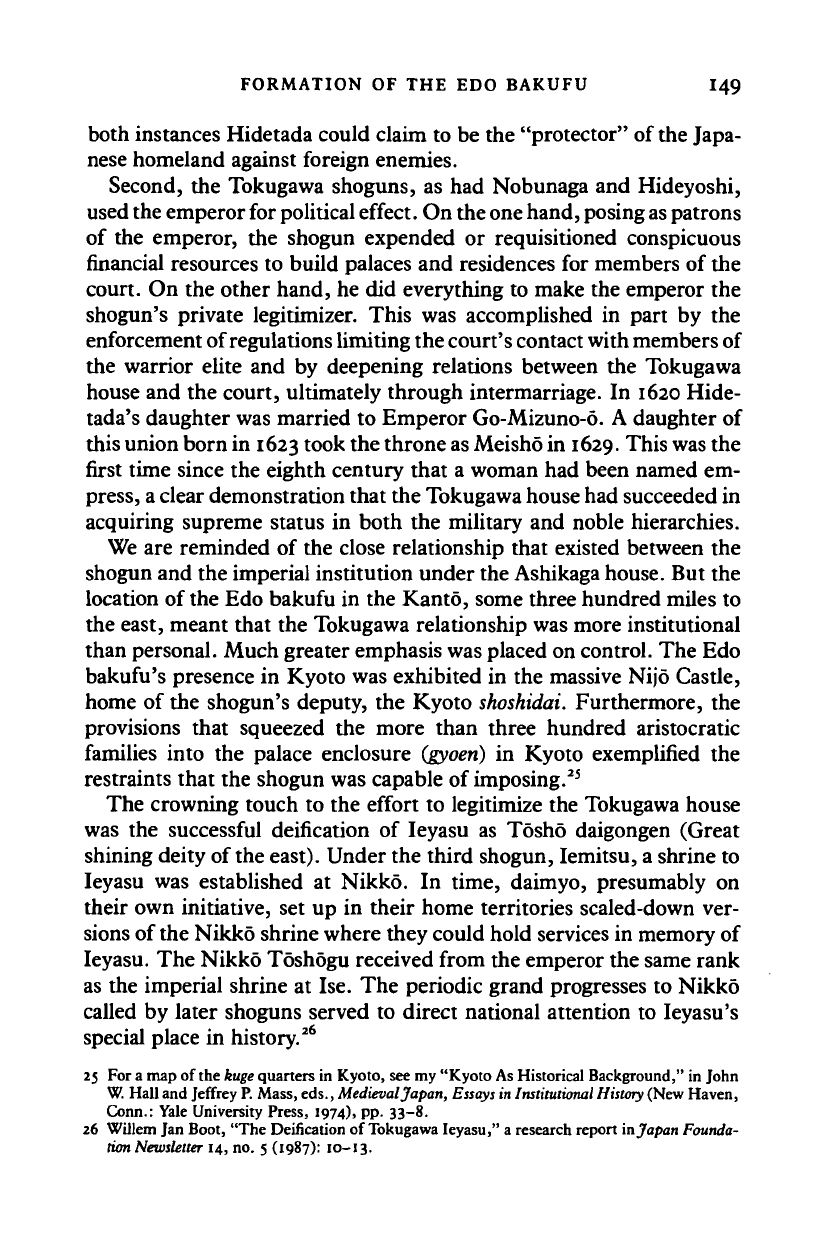
FORMATION OF THE EDO BAKUFU 149
both instances Hidetada could claim to be the "protector" of the Japa-
nese homeland against foreign enemies.
Second, the Tokugawa shoguns, as had Nobunaga and Hideyoshi,
used the emperor for political effect. On the
one
hand, posing
as
patrons
of the emperor, the shogun expended or requisitioned conspicuous
financial resources to build palaces and residences for members of the
court. On the other hand, he did everything to make the emperor the
shogun's private legitimizer. This was accomplished in part by the
enforcement of regulations limiting the court's contact with members
of
the warrior elite and by deepening relations between the Tokugawa
house and the court, ultimately through intermarriage. In 1620 Hide-
tada's daughter was married to Emperor Go-Mizuno-6. A daughter of
this union born in
1623
took the throne as Meisho in
1629.
This
was
the
first time since the eighth century that a woman had been named em-
press,
a
clear demonstration that the Tokugawa house had succeeded in
acquiring supreme status in both the military and noble hierarchies.
We are reminded of the close relationship that existed between the
shogun and the imperial institution under the Ashikaga house. But the
location of the Edo bakufu in the Kanto, some three hundred miles to
the east, meant that the Tokugawa relationship was more institutional
than personal. Much greater emphasis was placed on control. The Edo
bakufu's presence in Kyoto was exhibited in the massive Nijo Castle,
home of the shogun's deputy, the Kyoto
shoshidai.
Furthermore, the
provisions that squeezed the more than three hundred aristocratic
families into the palace enclosure
igyoen)
in Kyoto exemplified the
restraints that the shogun was capable of imposing.
25
The crowning touch to the effort to legitimize the Tokugawa house
was the successful deification of Ieyasu as Tosho daigongen (Great
shining deity of the
east).
Under the third shogun, Iemitsu, a shrine to
Ieyasu was established at Nikko. In time, daimyo, presumably on
their own initiative, set up in their home territories scaled-down ver-
sions of the Nikko shrine where they could hold services in memory of
Ieyasu. The Nikko Toshogu received from the emperor the same rank
as the imperial shrine at Ise. The periodic grand progresses to Nikko
called by later shoguns served to direct national attention to Ieyasu's
special place in history.
26
25 For a map of the kuge quarters in Kyoto, see my "Kyoto As Historical Background," in John
W. Hall and Jeffrey
P.
Mass, eds., Medieval Japan, Essays in Institutional
History
(New Haven,
Conn.: Yale University Press, 1974), pp. 33-8.
26 Willem Jan Boot, "The Deification of Tokugawa Ieyasu," a research report in Japan Founda-
tion Newsletter 14, no. 5 (1987):
10-13.
Cambridge Histories Online © Cambridge University Press, 2008
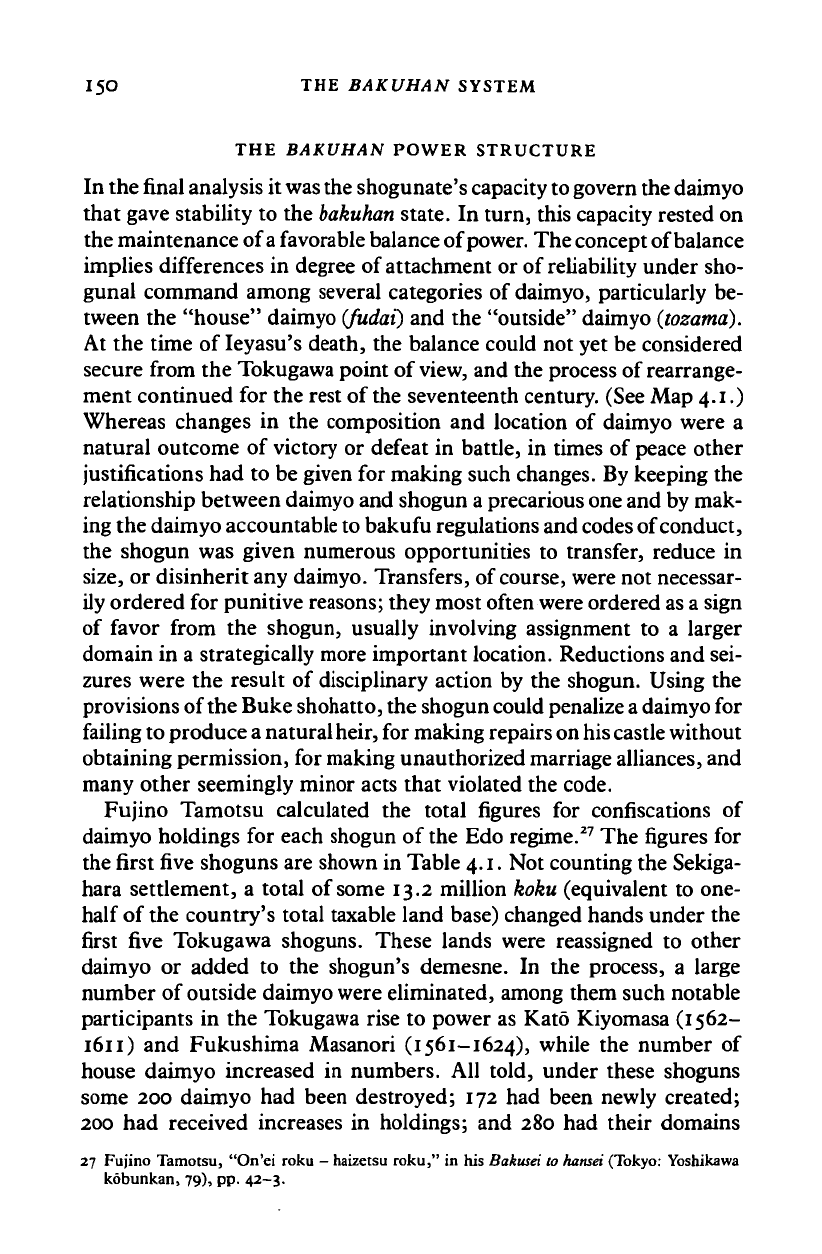
I5O THE BAKUHAN SYSTEM
THE BAKUHAN POWER STRUCTURE
In the
final
analysis it
was
the shogunate's capacity
to
govern the daimyo
that gave stability to the
bakuhan
state.
In
turn, this capacity rested on
the maintenance of
a
favorable balance of power. The concept of balance
implies differences
in
degree of attachment or of reliability under sho-
gunal command among several categories
of
daimyo, particularly
be-
tween
the
"house" daimyo
(fudai)
and
the "outside" daimyo
(tozama).
At
the
time
of
Ieyasu's death, the balance could not yet be considered
secure from the Tokugawa point
of
view,
and the process of rearrange-
ment continued
for
the rest
of
the seventeenth century. (See Map 4.1.)
Whereas changes
in the
composition
and
location
of
daimyo were
a
natural outcome
of
victory
or
defeat
in
battle,
in
times
of
peace other
justifications had
to
be given
for
making such changes. By keeping the
relationship between daimyo and shogun
a
precarious one and by mak-
ing the daimyo accountable to bakufu regulations and
codes
of conduct,
the shogun
was
given numerous opportunities
to
transfer, reduce
in
size,
or
disinherit any daimyo. Transfers, of course, were not necessar-
ily ordered
for
punitive reasons; they most often were ordered as a sign
of favor from
the
shogun, usually involving assignment
to a
larger
domain
in
a strategically more important location. Reductions and sei-
zures were
the
result
of
disciplinary action
by the
shogun. Using
the
provisions of the Buke shohatto, the shogun could penalize
a
daimyo for
failing to produce
a
natural
heir,
for making repairs
on his castle
without
obtaining permission, for making unauthorized marriage alliances, and
many other seemingly minor acts that violated the code.
Fujino Tamotsu calculated
the
total figures
for
confiscations
of
daimyo holdings
for
each shogun
of
the Edo regime.
27
The figures
for
the first five shoguns are shown in Table
4.1.
Not counting the Sekiga-
hara settlement,
a
total
of
some 13.2 million koku (equivalent
to
one-
half
of
the country's total taxable land base) changed hands under the
first five Tokugawa shoguns. These lands were reassigned
to
other
daimyo
or
added
to the
shogun's demesne.
In the
process,
a
large
number
of
outside daimyo were eliminated, among them such notable
participants
in the
Tokugawa rise
to
power as Kato Kiyomasa (1562-
1611)
and
Fukushima Masanori (1561-1624), while
the
number
of
house daimyo increased
in
numbers.
All
told, under these shoguns
some
200
daimyo
had
been destroyed;
172 had
been newly created;
200
had
received increases
in
holdings;
and 280 had
their domains
27 Fujino Tamotsu, "On'ei roku
-
haizetsu roku,"
in
his
Bakusei
to
hansei
(Tokyo: Yoshikawa
kobunkan, 79), pp. 42-3.
Cambridge Histories Online © Cambridge University Press, 2008
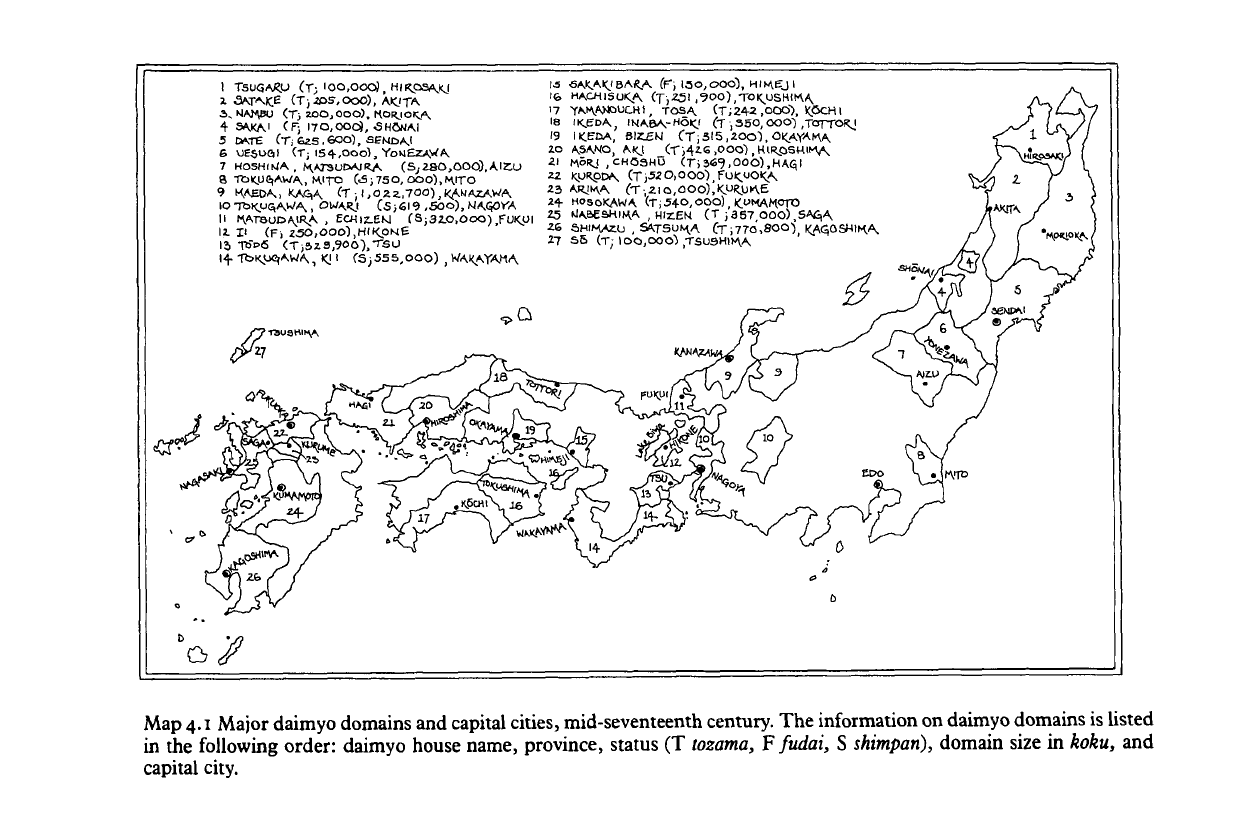
(r
>
100,000),
HIKOSAXJ
(T)20S-,000), AK.ITA
NAN\BU
(Tj
200,000), HORJOl^A,
SA.KAI
CF;
170,000), .SHONAI
DWTE
(Tj 625
.
SOO), SENi>A,(
UESOQI
Cr
;
iS't.ooo),
YouezA^A
HOSHlrJA , M.AT3UDAIRA (SjZSO.OOO),/
1
'VA,
M.IT°
(<S;7SO, OOOl.HITO
<AG)A. fT : I, O 2 i,
700),
)<AMAZAWA
•"'*
, OWARJ CS;SI9,50o),NA(50rA
™^^..^A
, ECWIZ.EM fSjazcOOO)^
II
(Fi
Z5O,OOO),HII<pNE
l XAK!BRA
16 HACHISUKA (T,-251 ,?00),TOK
v
USHIMA.
17 YW^AMOUCHI, TOSA. (T;242 ,000'), <5CHl
18 IK.BDA, INA6A.-HOK.I fr
,
360, OOO) .ToTTOR
19 IIC^DA BIZ£M CT3I5200XO<AYA
20
Z\
22
2 <yR$n\
CT^zo.ooJ.Fu^oC
23 ARJMA fT,2ICl,OOO)
)
K.URJJI\e
2+
HOSOKAWA
(T;
540,000) <ui*AKT
25 kJABESHlKA , HIZ1EN (T ;3S7,O0O),SAS,A,
^U , TSM. (T;770.SOO')
27 SS (T; 100,000) ,
Map
4.1
Major daimyo domains and capital
cities,
mid-seventeenth century. The information on daimyo domains is listed
in the following order: daimyo house name, province, status
(T
tozama,
F fudai, S
shimpan),
domain size
in
koku,
and
capital city.
Cambridge Histories Online © Cambridge University Press, 2008
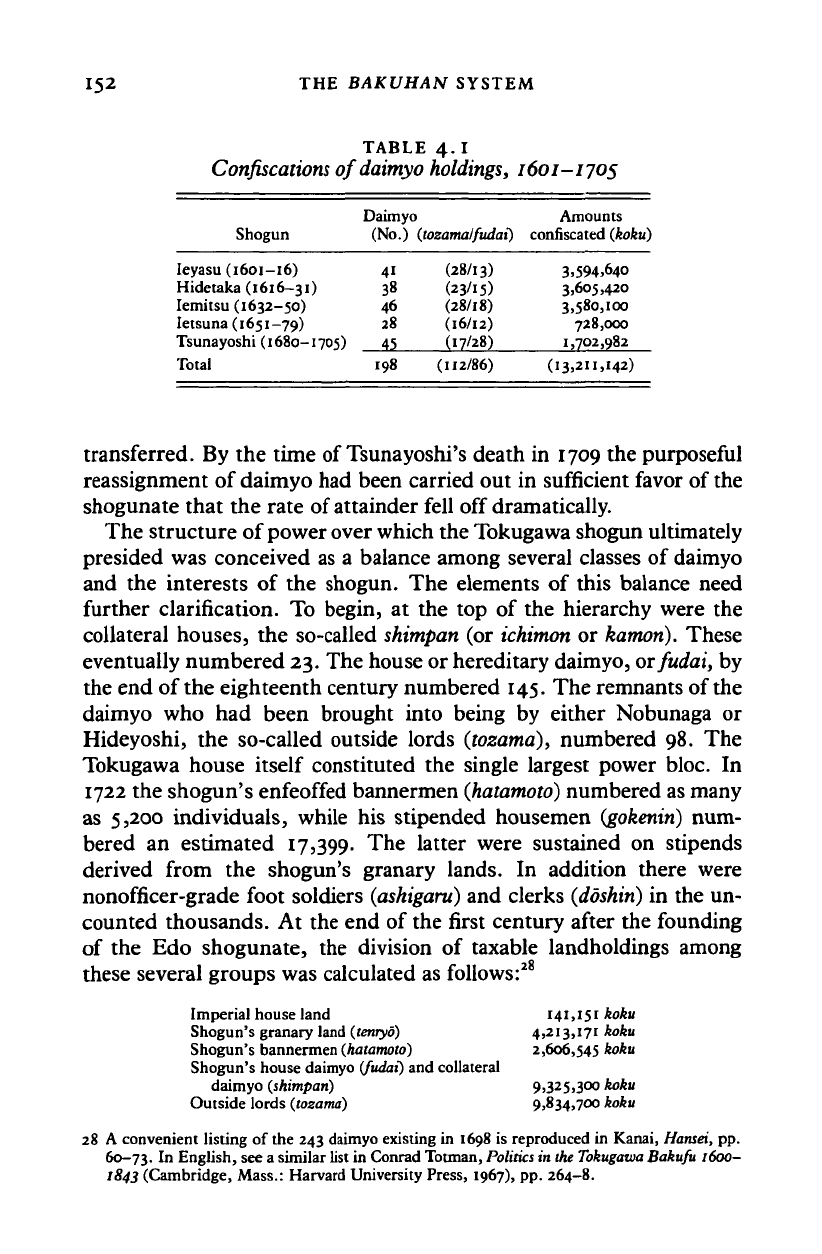
41
38
4
6
28
45
198
(28/i
3
)
(23/15)
(28/18)
(16/12)
(17/28)
(112/86)
3,594,640
3,605,420
3,580,100
728,000
1,702,982
(13,211,142)
152 THE BAKUHAN SYSTEM
TABLE 4.I
Confiscations
ofdaimyo
holdings,
1601-1705
Daimyo Amounts
Shogun
(No.)
(lozamalfudai)
confiscated
(koku)
Ieyasu (1601-16)
Hidetaka(l6i6-3i)
Iemitsu (1632-50)
Ietsuna (1651-79)
Tsunayoshi(1680-1705)
Total
transferred. By
the
time of Tsunayoshi's death
in
1709 the purposeful
reassignment
of
daimyo had been carried out
in
sufficient favor
of
the
shogunate that
the
rate of attainder fell
off
dramatically.
The structure of power over which the Tokugawa shogun ultimately
presided was conceived as
a
balance among several classes
of
daimyo
and
the
interests
of the
shogun.
The
elements
of
this balance need
further clarification.
To
begin,
at the top of the
hierarchy were
the
collateral houses,
the
so-called
shimpan
(or
ichimon
or
kamon).
These
eventually numbered
23.
The house or hereditary daimyo, or fudai,
by
the end
of
the eighteenth century numbered 145. The remnants
of
the
daimyo
who had
been brought into being
by
either Nobunaga
or
Hideyoshi,
the
so-called outside lords (tozama), numbered
98. The
Tokugawa house itself constituted
the
single largest power bloc.
In
1722 the shogun's enfeoffed bannermen
(hatamoto)
numbered as many
as
5,200
individuals, while
his
stipended housemen
(gokenin)
num-
bered
an
estimated 17,399.
The
latter were sustained
on
stipends
derived from
the
shogun's granary lands.
In
addition there were
nonofficer-grade foot soldiers
(ashigaru)
and
clerks
(ddshin)
in
the un-
counted thousands.
At
the end
of
the first century after the founding
of
the Edo
shogunate,
the
division
of
taxable landholdings among
these several groups was calculated as follows:
28
Imperial house land 141,151 koku
Shogun's granary land
(lenryo)
4,213,171 koku
Shogun's bannermen {hatamoto) 2,606,545 koku
Shogun's house daimyo (fudai) and collateral
daimyo (shimpan) 9,325,300 koku
Outside lords (tozama) 9,834,700 koku
28
A
convenient listing
of
the
243
daimyo existing
in
1698
is
reproduced
in
Kanai, Hansei,
pp.
60-73.
I
n
English, see a similar list
in
Conrad Totman, Politics in the
Tokugawa
Bakufu
1600-
1843 (Cambridge, Mass.: Harvard University Press, 1967), pp. 264-8.
Cambridge Histories Online © Cambridge University Press, 2008
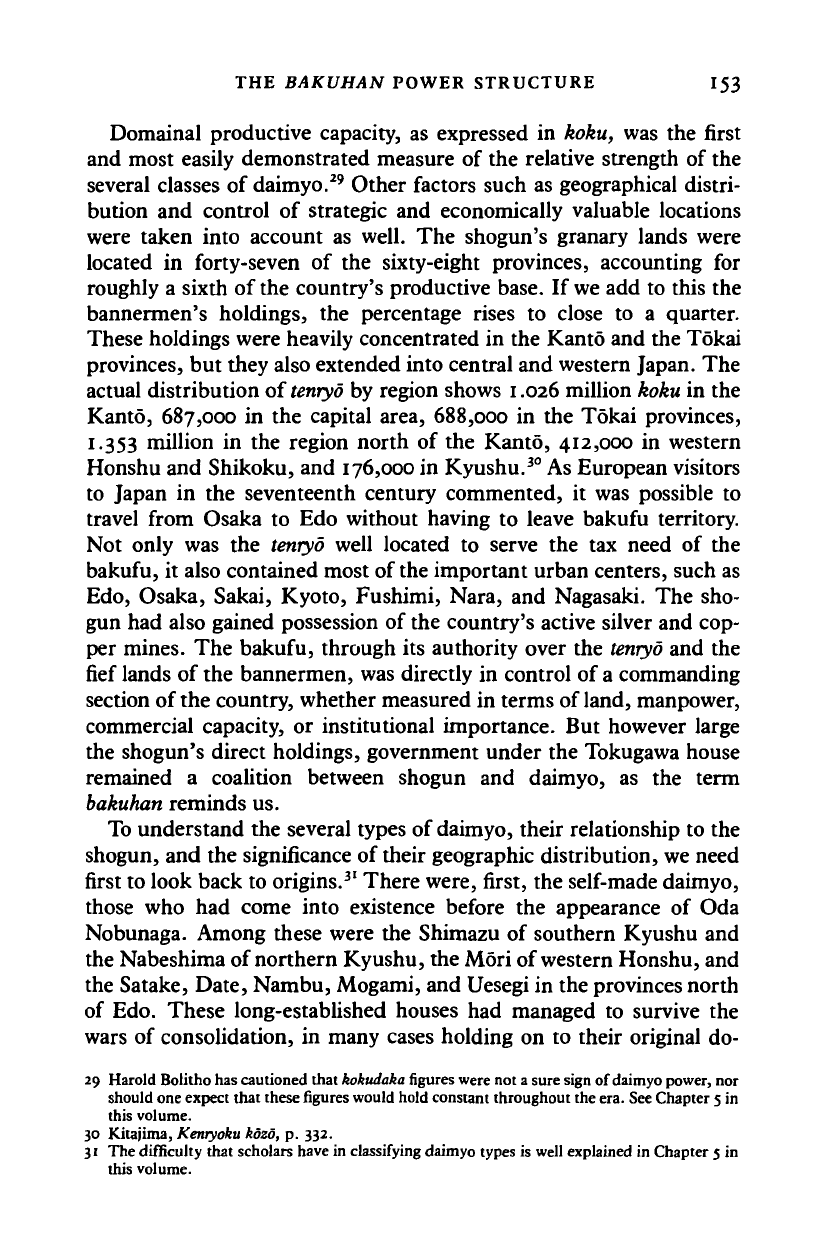
THE BAKUHAN POWER STRUCTURE 153
Domainal productive capacity, as expressed in koku, was the first
and most easily demonstrated measure of the relative strength of the
several classes of daimyo.
29
Other factors such as geographical distri-
bution and control of strategic and economically valuable locations
were taken into account as well. The shogun's granary lands were
located in forty-seven of the sixty-eight provinces, accounting for
roughly a sixth of the country's productive base. If
we
add to this the
bannermen's holdings, the percentage rises to close to a quarter.
These holdings were heavily concentrated in the Kanto and the Tokai
provinces, but they also extended into central and western Japan. The
actual distribution of
tenryo
by region shows 1.026 million
koku
in the
Kanto, 687,000 in the capital area, 688,000 in the Tokai provinces,
1.353 million in the region north of the Kanto, 412,000 in western
Honshu and Shikoku, and 176,000 in Kyushu.
30
As
European visitors
to Japan in the seventeenth century commented, it was possible to
travel from Osaka to Edo without having to leave bakufu territory.
Not only was the
tenryo
well located to serve the tax need of the
bakufu, it also contained most of the important urban centers, such as
Edo,
Osaka, Sakai, Kyoto, Fushimi, Nara, and Nagasaki. The sho-
gun had also gained possession of the country's active silver and cop-
per mines. The bakufu, through its authority over the
tenryo
and the
fief lands of the bannermen, was directly in control of
a
commanding
section of the country, whether measured in terms of
land,
manpower,
commercial capacity, or institutional importance. But however large
the shogun's direct holdings, government under the Tokugawa house
remained a coalition between shogun and daimyo, as the term
bakuhan
reminds us.
To understand the several types of
daimyo,
their relationship to the
shogun, and the significance of their geographic distribution, we need
first to look back to origins.
31
There were, first, the self-made daimyo,
those who had come into existence before the appearance of Oda
Nobunaga. Among these were the Shimazu of southern Kyushu and
the Nabeshima of northern Kyushu, the Mori of western Honshu, and
the Satake, Date, Nambu, Mogami, and Uesegi in the provinces north
of Edo. These long-established houses had managed to survive the
wars of consolidation, in many cases holding on to their original do-
29 Harold Bolitho has cautioned that kokudaka
figures
were not a sure sign of daimyo power, nor
should one expect that these figures would hold constant throughout the era. See Chapter 5 in
this volume.
30 Kitajima, Kenryoku kdzo, p. 332.
31 The difficulty that scholars have in classifying daimyo types is well explained in Chapter 5 in
this volume.
Cambridge Histories Online © Cambridge University Press, 2008
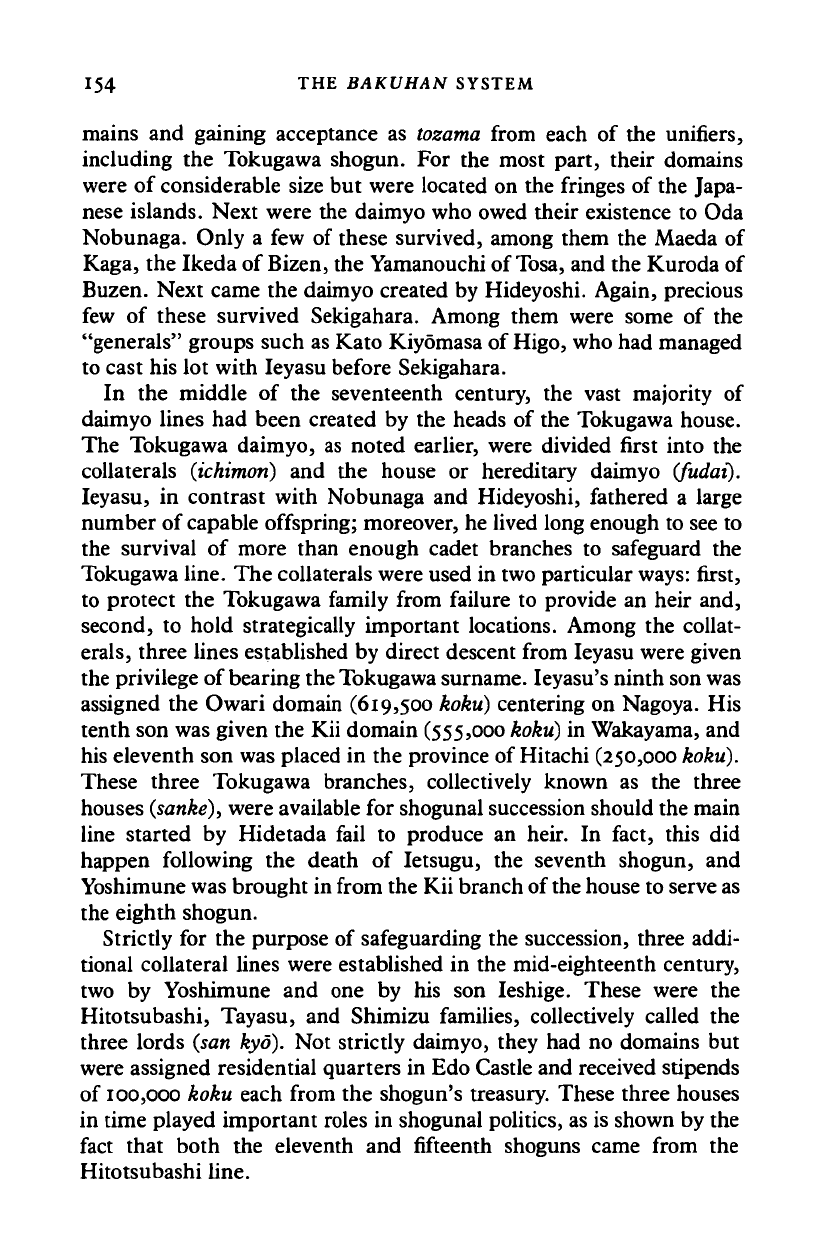
154 THE BAKUHAN SYSTEM
mains and gaining acceptance as tozama from each of the unifiers,
including the Tokugawa shogun. For the most part, their domains
were of considerable size but were located on the fringes of the Japa-
nese islands. Next were the daimyo who owed their existence to Oda
Nobunaga. Only a few of these survived, among them the Maeda of
Kaga, the Ikeda of Bizen, the Yamanouchi of
Tosa,
and the Kuroda of
Buzen. Next came the daimyo created by Hideyoshi. Again, precious
few of these survived Sekigahara. Among them were some of the
"generals" groups such as Kato Kiyomasa of Higo, who had managed
to cast his lot with Ieyasu before Sekigahara.
In the middle of the seventeenth century, the vast majority of
daimyo lines had been created by the heads of the Tokugawa house.
The Tokugawa daimyo, as noted earlier, were divided first into the
collaterals (ichimon) and the house or hereditary daimyo (fudai).
Ieyasu, in contrast with Nobunaga and Hideyoshi, fathered a large
number of capable offspring; moreover, he lived long enough to see to
the survival of more than enough cadet branches to safeguard the
Tokugawa line. The collaterals were used in two particular
ways:
first,
to protect the Tokugawa family from failure to provide an heir and,
second, to hold strategically important locations. Among the collat-
erals,
three lines established by direct descent from Ieyasu were given
the privilege of bearing the Tokugawa surname. Ieyasu's ninth son was
assigned the Owari domain (619,500 koku) centering on Nagoya. His
tenth son was given the Kii domain (555,000
koku)
in Wakayama, and
his eleventh son was placed in the province of Hitachi (250,000 koku).
These three Tokugawa branches, collectively known as the three
houses
(sanke),
were available for shogunal succession should the main
line started by Hidetada fail to produce an heir. In fact, this did
happen following the death of Ietsugu, the seventh shogun, and
Yoshimune was brought in from the Kii branch of the house to serve as
the eighth shogun.
Strictly for the purpose of safeguarding the succession, three addi-
tional collateral lines were established in the mid-eighteenth century,
two by Yoshimune and one by his son Ieshige. These were the
Hitotsubashi, Tayasu, and Shimizu families, collectively called the
three lords (san kyo). Not strictly daimyo, they had no domains but
were assigned residential quarters in Edo Castle and received stipends
of 100,000 koku each from the shogun's treasury. These three houses
in time played important roles in shogunal politics, as is shown by the
fact that both the eleventh and fifteenth shoguns came from the
Hitotsubashi line.
Cambridge Histories Online © Cambridge University Press, 2008
